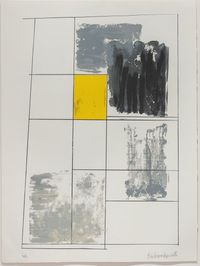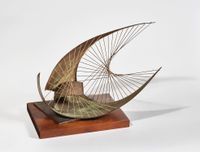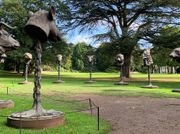Barbara Hepworth was a pioneering British modernist sculptor interested carving simple organic forms in marble, stone, and wood. She also made bronzes, drawings, and lithographic prints. Hepworth, with her friends, helped introduce a radical continental aesthetic to a conservative island nation.
Read MoreEducated at Wakefield Girls High School, Hepworth won a scholarship to go to Leeds School of Art in 1920. There she met Henry Moore, who became a life-long friend and affectionate rival. In 1921, they went to London to study at the Royal College of Art for four years, making the occasional study trip to Paris.
In 1924, she was awarded a West Riding Scholarship for a year's travel and went to Italy to study Romanesque and early Renaissance art, nurturing her classical sensibility. In Florence, she married fellow artist, John Skeaping, and in Rome she learned to carve marble from Giovanni Ardini.
When Skeaping became ill, he and Hepworth returned to London in 1926. In 1931, she met the painter and chair of the experimental Seven and Five society, Ben Nicholson, and they became romantically involved. She separated from Skeaping in 1931 and married Nicholson in 1938.
Nicholson was passionate about abstraction, but like Hepworth, curious about Surrealism, so they went to Paris in 1933, visiting the studios of Pablo Picasso, Constantin Brancusi, and Jean Arp. Back in London, they co-founded the Unit One art movement, which aimed at uniting the two genres. In 1934, Hepworth had triplets, but managed to continue her practice as well as raise children.
In 1935, she and Nicholson met Piet Mondrian, Wassily Kandinsky, and Naum Gabo. Some of her works began to show the influence of the School of Paris, such as the Brancusi-like Two Segments and Sphere (1935—1936), in marble.
In 1939, Hepworth and Nicholson moved to the Cornish fishing village of St. Ives where they attracted other painters and sculptors, as well as some overseas artists like Gabo. It became a very highly regarded and popular art centre, for a time second only to London.
Due to the war, and one studio being destroyed by bombs, Hepworth and Nicholson moved to Carbis Bay at the end of 1939, where there was a studio and garden. In 1947, Hepworth began a series of drawings of surgeons operating in hospitals. She saw multiple connections between artists and hospital staff: 'There is, it seems to me, a close affinity between the work and approach of both physicians and surgeons, and painters and sculptors.'
[Artworks Content]__
On Ocula, the artist is represented by Pace Gallery.
Barbara Hepworth's website can be found here.
John Hurrell | Ocula | 2021






